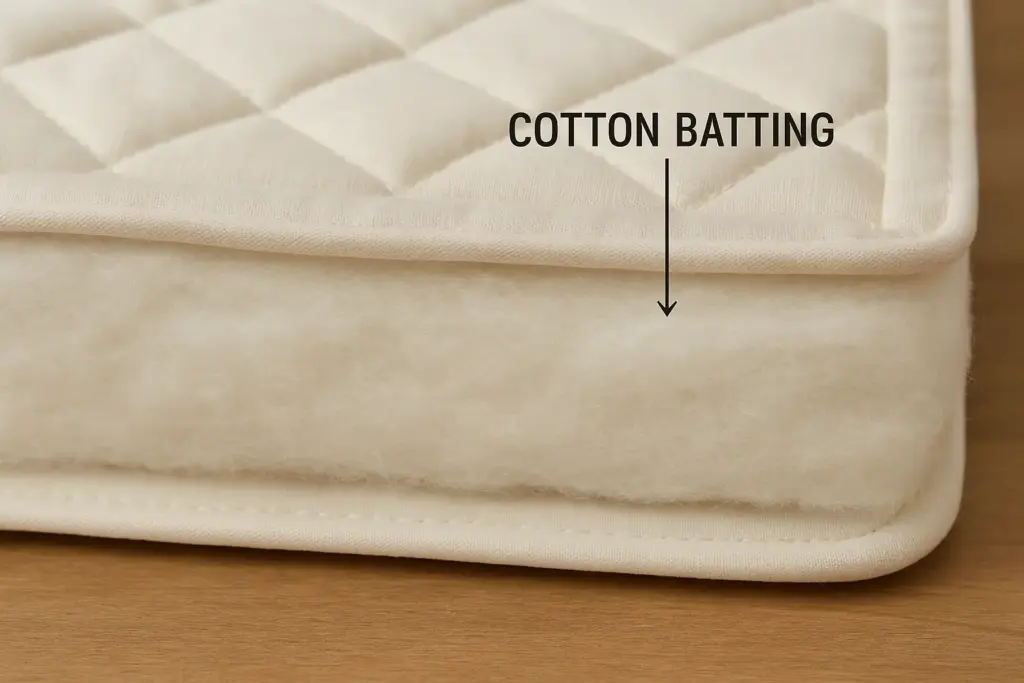Cotton batting is a natural fiber filling widely used in the bedding, quilting, upholstery, and craft industries. Known for its breathability, softness, and sustainability, it remains a top choice among manufacturers seeking eco-conscious, hypoallergenic, and functional padding solutions.
This article explores what cotton batting is, its types, performance features, and why it continues to be a preferred fill material in both large-scale production and artisanal markets.
1. What Is Cotton Batting?
Cotton batting refers to layers of loosely collected cotton fibers—processed, cleaned, and mechanically bonded into a soft, flat sheet or roll. It serves as a middle insulating layer in multi-layered textile products, most commonly between outer fabrics.
Key properties:
- Made from 100% natural cotton (sometimes blended)
- Soft, breathable, and hypoallergenic
- Available in rolls, sheets, or pre-cut sizes
- Washable and biodegradable
- Compressible, but retains loft with quality processing
2. Types of Cotton Batting
Cotton batting varies by fiber source, bonding method, and end-use application:
| Type | Features | Application |
|---|---|---|
| 100% Cotton | Natural, breathable, best for heirloom quilts | High-end bedding, crafts |
| Needle-Punched Cotton | Densely bonded using barbed needles, flat and stable | Quilts, mattress pads, upholstery |
| Scrim-Cotton | Needle-punched with lightweight polyester scrim for stability | Machine quilting and commercial bedding |
| Organic Cotton | Grown without pesticides or GMOs | Sustainable bedding, infant products |
| Cotton-Poly Blends | Improved durability and flexibility | Cost-effective bulk products |
Scrim batting is especially useful for high-speed quilting machines and industrial applications, as it prevents stretching and bunching.

3. Benefits of Cotton Batting
From both a material science and user experience perspective, cotton batting offers a range of advantages:
- Breathability – Allows air circulation, making it ideal for warm climates
- Hypoallergenic – Naturally resistant to dust mites and chemical-free when unbleached
- Eco-friendly – Biodegradable and often compostable
- Thermal insulation – Offers light-to-medium warmth, ideal for year-round use
- Smooth texture – Helps reduce shifting within quilted or sewn products
For manufacturers in bedding or baby products, cotton batting aligns with consumer preferences for natural and chemical-free interiors.
4. Common Uses in Textile Products
Bedding
- Duvet inserts
- Mattress pads
- Pillow fillers (inner core)
Quilting & Sewing
- Traditional quilts (especially heirloom or hand-stitched)
- Wall hangings
- Table runners
Upholstery & Crafts
- Cushion padding
- Pet beds
- Insulated pot holders, soft toys
Cotton batting is often layered between outer fabric shells, then quilted to hold it in place and prevent shifting over time.
5. Storage, Handling & Production Notes
Cotton batting must be stored and handled with care to maintain performance:
- Keep in a dry, clean environment to avoid moisture retention
- Avoid over-compression in packaging, which may reduce loft
- Allow ventilation before use to restore natural fluffiness
- Cut with sharp blades or rolling cutters to prevent fiber snagging
Roll width typically ranges from 90 cm to 280 cm, with custom GSM (grams per square meter) options from 150–600 GSM depending on the application.
6. B2B Supply & Sourcing Considerations
For wholesale buyers or product developers, choosing the right cotton batting involves:
- GSM customization based on product type (e.g., 150 GSM for summer quilts, 400+ for winter bedding)
- Certifications such as OEKO-TEX®, GOTS (for organic cotton), or REACH compliance
- Minimum order quantities (usually starting at 500–1,000 kg per specification)
- Roll or sheet packaging options
- OEM availability for private label bedding brands
Conclusion
Cotton batting is a time-tested filling material valued for its natural origin, breathability, and soft insulation. It continues to be a strategic material across a wide spectrum of product categories—from high-end quilts to sustainable home goods. For B2B buyers and textile manufacturers, sourcing high-quality cotton batting offers a competitive edge in meeting the growing demand for natural, chemical-free, and comfortable products.


Leave a Reply